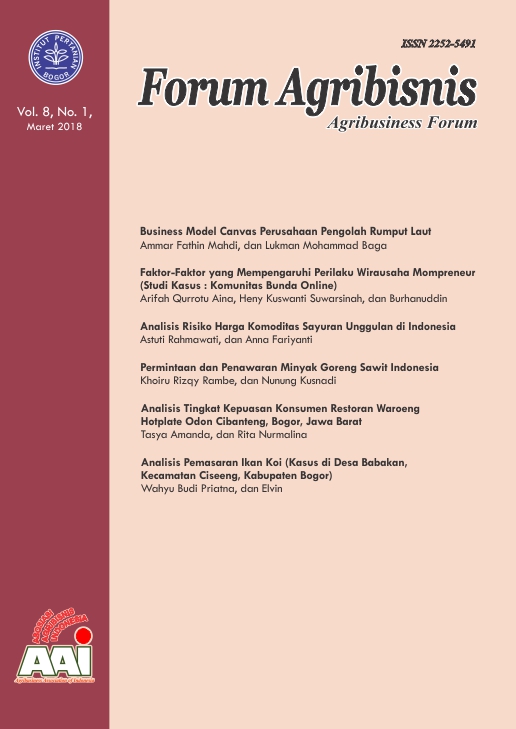ANALISIS RISIKO HARGA KOMODITAS SAYURAN UNGGULAN DI INDONESIA
Main Article Content
Abstract
Chilies, potatoes, shallots, and cabbage are five main vegetables that have high rates of production, but they also have high levels of price fluctuation. The purpose of this study was to analyze the levels of price risk and analyze alternative strategies needed to reduce the price risk of chilies, potatoes, shallots, and cabbage. The method of analysis that used in this research is ARCH/GARCH model, Value at Risk (VaR), and coefficient variation. The results showed that the price of chilies, tomatoes, and potatoes were influenced by price volatility and variants in previous periods. The price volatility and variants of shallots and cabbages were influenced by the prices of one and two previous periods. The calculation of VaR, which was based on the total capital in a one-day sale period showed that price risk of chilies, potatoes, shallots, and cabbage were at 4.077 persen, 3.078 persen, 5.240 persen, 6.879 persen, dan 3.980 persen. Based on coefficient variation showed that tomatoes had the highest price risk was at 0.428 while potatoes was found to have the lowest price risk was at 0.080. Shallot had the second highest price risk was at 0.195. Cabbage and chilies had the third and the forth highest price risk were at 0.209 and 0.349. Alternative strategy to solve the price risk of vegetables need to be applied by traders, farmers, and government.
Downloads
Download data is not yet available.
Article Details
How to Cite
RahmawatiA., & FariyantiA. (2018). ANALISIS RISIKO HARGA KOMODITAS SAYURAN UNGGULAN DI INDONESIA. Forum Agribisnis : Agribusiness Forum, 8(1), 35-60. https://doi.org/10.29244/fagb.8.1.35-60
Section
Articles
The author submitting the manuscript must understand and agree that the copyright of the article manuscript must be submitted/transferred to the Journal Forum Agribisnis. This work is licensed under the Creative Commons Attribution-ShareAlike 4.0 (CC BY-SA) International License in which the Author and Reader can copy and redistribute the material in any media or format, and remix, modify and build material for any purpose, but they must provide appropriate credit (citing articles or content), provide a link to the license, and indicate whether there is a change. If you mix, change, or create material, you must distribute your contribution under the same license as the original.
References
Amri MK. 2009. Risiko Harga Sayuran di Indonesia [skripsi]. Institut Pertanian. Bogor.
Apriani LN. 2011. Analisis Efesiensi Teknis dan Pendapatan Usahatani Bawang Merah [skripsi]. Institut Pertanian. Bogor.
Ariefianto MD. 2012. Ekonometrika Esensi dan Aplikasi dengan Menggunakan Eviews. Penerbit Erlangga. Jakarta.
[DJHKP] Direktorat Jenderal Hortikultura. 2014. Produksi Tanaman Sayuran di Indonesia Tahun 2009-2013[internet]. http://horti.pertanian.go.id/node/253. Diakses 15 Januari 2015]
Engle R. 2001. GARCH 101: The Use of ARCH/GARCH Models in Applied Econometrics. Journal of Economic Perspectives, 15 (4): 157-168.
Firdaus. 2011. Aplikasi Ekonometrika untuk Data Panel dan Time Series. IPB Press. Bogor
Herviyani N. 2009. Risiko harga kubis dan bawang merah di Indonesia [skripsi]. Institut Pertanian. Bogor.
Industri. 2014. Bawang Merah Permerintah Lakukan Impor Petani Lokal Melarang. http://industri.bisnis.com/read/20140427/99/222715/bawang-merah-pemerintah-lakukan-impor-petani-lokal-meradang. Diakses pada 5 Mei 2015.
Jorion P. 2002. Value at Risk: The New Benchmark for Managing Financial Risk Second Edition. Mc Graw-Hill California. North America.
Republika online. 2012. Jelang lebaran, harga cabai merah meroket. [Terhubung Berkala]. http://www.republika.co.id/berita/ramadhan/kabar-ramadhan/12/08/12/m8m3pl-jelang-lebaran-harga-cabai-merah-meroket (20 April 2015).
Sari RM. 2009. Risiko Harga cabai merah keriting dan cabai merah besar di Indonesia [skripsi]. Institut Pertanian Bogor. Bogor.
Siregar NM. 2011. Analisis Pendapatan Usahatani dan Faktor-Faktor yang Mempengaruhi Produksi Cabai di Desa Citapen, Kecamatan Ciawi, Kabupaten Bogor [skripsi]. Institut Pertanian Bogor. Bogor.
Sitompul AR. 2013. Analisis Pendapatan dan Faktor-Faktor yang mempengaruhi Produksi Usahatani Kubis di kecamatan Pangalengan Kabupaten Bandung Jawa Barat [skripsi]. Institut Pertanian. Bogor.
Soekartawi. 2002. Prinsip Dasar Ekonomi Pertanian: Teori dan Aplikasi. PT Raja Grafindo Persada. Jakarta.
Sujana W. 2010. Analisis Pendapatan dan Faktor-Faktor yang Mempengaruhi Usahatani Tomat di Desa Lebak Muncan, Kecamatan Ciwide, Kabupaten Bandung [skripsi]. Institut Pertanian Bogor. Bogor.
Apriani LN. 2011. Analisis Efesiensi Teknis dan Pendapatan Usahatani Bawang Merah [skripsi]. Institut Pertanian. Bogor.
Ariefianto MD. 2012. Ekonometrika Esensi dan Aplikasi dengan Menggunakan Eviews. Penerbit Erlangga. Jakarta.
[DJHKP] Direktorat Jenderal Hortikultura. 2014. Produksi Tanaman Sayuran di Indonesia Tahun 2009-2013[internet]. http://horti.pertanian.go.id/node/253. Diakses 15 Januari 2015]
Engle R. 2001. GARCH 101: The Use of ARCH/GARCH Models in Applied Econometrics. Journal of Economic Perspectives, 15 (4): 157-168.
Firdaus. 2011. Aplikasi Ekonometrika untuk Data Panel dan Time Series. IPB Press. Bogor
Herviyani N. 2009. Risiko harga kubis dan bawang merah di Indonesia [skripsi]. Institut Pertanian. Bogor.
Industri. 2014. Bawang Merah Permerintah Lakukan Impor Petani Lokal Melarang. http://industri.bisnis.com/read/20140427/99/222715/bawang-merah-pemerintah-lakukan-impor-petani-lokal-meradang. Diakses pada 5 Mei 2015.
Jorion P. 2002. Value at Risk: The New Benchmark for Managing Financial Risk Second Edition. Mc Graw-Hill California. North America.
Republika online. 2012. Jelang lebaran, harga cabai merah meroket. [Terhubung Berkala]. http://www.republika.co.id/berita/ramadhan/kabar-ramadhan/12/08/12/m8m3pl-jelang-lebaran-harga-cabai-merah-meroket (20 April 2015).
Sari RM. 2009. Risiko Harga cabai merah keriting dan cabai merah besar di Indonesia [skripsi]. Institut Pertanian Bogor. Bogor.
Siregar NM. 2011. Analisis Pendapatan Usahatani dan Faktor-Faktor yang Mempengaruhi Produksi Cabai di Desa Citapen, Kecamatan Ciawi, Kabupaten Bogor [skripsi]. Institut Pertanian Bogor. Bogor.
Sitompul AR. 2013. Analisis Pendapatan dan Faktor-Faktor yang mempengaruhi Produksi Usahatani Kubis di kecamatan Pangalengan Kabupaten Bandung Jawa Barat [skripsi]. Institut Pertanian. Bogor.
Soekartawi. 2002. Prinsip Dasar Ekonomi Pertanian: Teori dan Aplikasi. PT Raja Grafindo Persada. Jakarta.
Sujana W. 2010. Analisis Pendapatan dan Faktor-Faktor yang Mempengaruhi Usahatani Tomat di Desa Lebak Muncan, Kecamatan Ciwide, Kabupaten Bandung [skripsi]. Institut Pertanian Bogor. Bogor.

